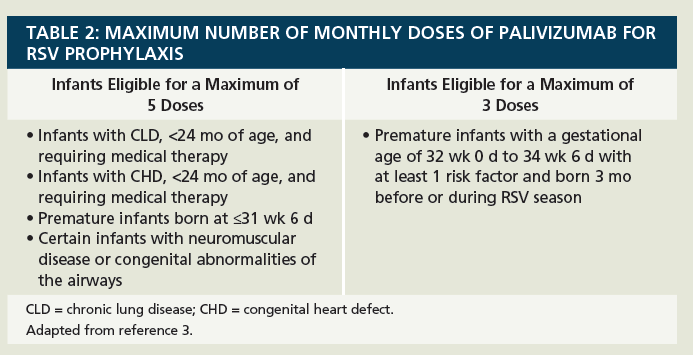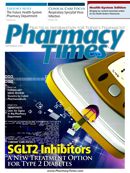Publication
Article
Pharmacy Practice in Focus: Health Systems
Respiratory Syncytial Virus Infection: Treatment and Prophylaxis
Author(s):
Background
Respiratory syncytial virus (RSV) is a common pathogen responsible for respiratory infections in children. Most children experience an infection caused by RSV by the age of 2 to 3 years. RSV infection typically presents as a mild upper respiratory tract infection (URTI) that is self-resolving. However, infants and young children with underlying risk factors are at greatest risk of severe RSV infection, characterized by breathing difficulty, which warrants immediate medical attention and potential hospitalization.1,2
Epidemiology and Etiology
In North America, RSV infections commonly occur on an annual basis from November through April. RSV causes more than 30 million cases of lower respiratory tract infection yearly, with more than 60,000 children less than 5 years of age requiring hospitalization.2,3 Infection occurs in 70% of children less than 12 months old, with almost all children infected by 2 years of age.3,4
RSV is a nonsegmented, negativestranded RNA virus of the Pneumovirus genus, Paramyxoviridae family. The A and B subtypes of the virus comprise the majority of circulating, seasonal RSV strains.1 Viral proteins G and F are recognized for their roles in epithelial cell attachment and host cell entry, respectively.5 Once RSV exposure occurs, the end location for infection to take place is within the passages of the upper or lower respiratory tract.1
RSV infection results in a spectrum of illness that includes upper respiratory tract (URT) symptoms such as cough, coryza, rhinorrhea, and conjunctivitis, as well as lower respiratory tract (LRT) conditions such as bronchospasm, bronchiolitis, pneumonia, and respiratory failure requiring mechanical ventilation.4,6 Of note, a previous infection does not reduce the risk of future reinfection with RSV, which is quite common.2,3 There has been speculation that children with prior LRT infections such as bronchiolitis may go on to develop recurrent wheezing, with an increased risk for development of asthma. However, no definitive data are currently available to clearly support this association.1,5
Risk Factors
Individuals at greatest risk of severe RSV infections are those with preterm birth, congenital heart disease, congenital lung disease, neuromuscular disease, age less than 6 months, male gender, household siblings less than 5 years of age, active day care attendance, and passive exposure to household tobacco smoke.3
Treatment of RSV
Supportive care includes adequate hydration, oxygen supplementation, and additional management of symptoms or comorbid conditions such as bronchiolitis, and is the relative standard of care in regard to management of RSV infection.5 The only FDA-approved medication for the treatment of RSV infection is ribavirin, an antiviral agent, but its routine use is not recommended.7 Ribavirin exerts its action through inhibition of viral polymerase activity and prevention of RNA and DNA synthesis. Its role in RSV treatment is relatively limited due to its high monetary cost, lack of robust clinical evidence, and its unfavorable safety profile which includes possible development of hemolytic anemia, neuropsychiatric effects, ophthalmologic disorders, and hypersensitivity reactions.8 Ribavirin may be an appropriate therapy for children with severe RSV infection with comorbid immunosuppression, but more data are needed.1,2
Prophylaxis of RSV
With lack of efficacious treatment options available for RSV infections, the ideal approach to therapy is active prevention. RSV can be transmitted through droplets or direct contact with secretions and can remain active on various surfaces and fabrics for several hours. Methods such as thorough hand washing; cleaning of counter surfaces, door knobs, and children’s toys; and washing of clothes and linens should be performed consistently to reduce RSV transmission. Also, restricting the amount of exposure to crowded environments or day care settings should be considered.9

Besides nonpharmacologic prevention of RSV, there is a pharmacologic prophylactic agent available. Palivizumab is approved for the prevention of serious RSV-induced LRTI in children with risk factors for severe infection. It is a recombinant monoclonal antibody that binds onto RSV surface protein F and prevents viral fusion and replication in host cells. Of note, palivizumab is not a vaccine, although it provides passive immunity against RSV. Recommended indications for use and maximum number of doses of palivizumab are based upon eligibility criteria established by the American Academy of Pediatrics, listed in Table 2 and Online Table 3.3 Monthly administrations should not be delayed and caregiver compliance should be encouraged, since the elimination halflife is approximately 25 days in pediatric patients.10 Although a child may receive palivizumab, it does not necessarily prevent them from developing an RSV infection. Any infection would likely be less severe in nature.5 Palivizumab is administered intramuscularly as a 15 mg/kg monthly dose and is commercially available in 50 mg/0.5 mL or 100 mg/1 mL preservative-free liquid vials.10 It is well tolerated, with rash, injection site erythema, swelling, and fever observed in some patients in previous studies.5
Summary
In conclusion, RSV is a respiratory pathogen that can be problematic in infants and young children with risk factors for severe infection. Optimal protection against RSV is active prevention through proper hygiene and the administration of palivizumab in highrisk children.
Daniel T. Lui, PharmD, is a PGY2 pediatric specialty pharmacy resident at North Carolina Children’s Hospital at UNC Medical Center in Chapel Hill, NC.
References
1. Dawson-Caswell M, Muncie HL Jr. Respiratory syncytial virus infection in children. Am Fam Physician. 2011;83(2):141-146.
2. Turner TL, Kopp BT, Paul G, et al. Respiratory syncytial virus: current and emerging treatment options. Clinicoecon Outcomes Res. 2014;6:217-225.
3. American Academy of Pediatrics Committee on Infectious Diseases. Modified recommendations for use of palivizumab for prevention of respiratory syncytial virus infections. Pediatrics. 2009;124(6):1694-1701.
4. Glezen WP, Taber LH, Frank AL, Kasel JA. Risk of primary infection and reinfection with respiratory syncytial virus. Am J Dis Child. 1986;140(6):543-546.
5. Mejias A, Ramilo O. Review of palivizumab in the prophylaxis of respiratory syncytial virus (RSV) in high-risk infants. Biologics. 2008;2(3):433-439.
6. Hall CB, Long CE, Schnabel KC. Respiratory syncytial virus infections in previously healthy working adults. Clin Infect Dis. 2001;33(6):792-796.
7. American Academy of Pediatrics Committee on Infectious Diseases. Reassessment of the indications for ribavirin therapy in respiratory syncytial virus infections. Pediatrics. 1996;97(1):137-140.
8. Virazole [package insert]. Bridgewater, NJ: Valeant; 2013.
9. National Center for Immunization and Respiratory Diseases, Division of Viral Diseases. Respiratory syncytial virus. Atlanta, GA: Centers for Disease Control and Prevention. www.cdc.gov/rsv/about/transmission.html. Accessed May 30, 2014.
10. Synagis [package insert]. Gaithersburg, MD: MedImmune; 2014.







